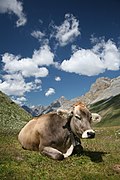| Sesvenna Alps | |
|---|---|
 | |
| Highest point | |
| Peak | Piz Sesvenna |
| Elevation | 3,204 m (10,512 ft) |
| Coordinates | 46°42′21″N10°24′10″E / 46.70583°N 10.40278°E |
| Geography | |
| Countries |
|
| States |
|
| Parent range | Central Eastern Alps |
The Sesvenna Alps are a mountain range located in the Alps of eastern Switzerland, northern Italy and western Austria.







